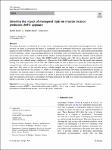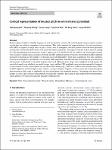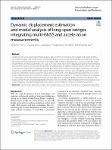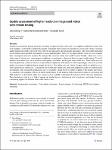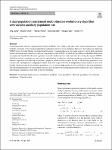Search
Author
- Amir, Ebrahimi (2)
- Aydin, Azizi (2)
- George, Haller (2)
- James, M. Fiore (2)
- next >
Subject
- Engineering (4)
- công nghệ (3)
- kỹ thuật (3)
- Robotics (3)
- next >
Date issued
Search Results
Investment decisions are influenced by various factors, including personal characteristics and managerial issues. In this research, we aimed to investigate the impact of managerial traits on investment decisions by using adaptive neuro-fuzzy inference system (ANFIS) to develop a personalized investment recommendation system. We collected data from potential investors through a survey, which included questions on investment-types, investment habits, and managerial traits. The survey data were used to create an ANFIS model, which is a hybrid model that combines the strengths of both artificial neural networks and fuzzy logic systems. The ANFIS model was trained using 1542 survey data pairs, and the model's performance was evaluated using a validation set. The results of the ANFIS mode... |
Neural coding of auditory stimulus frequency is well-documented; however, the cortical signals and perceptual correlates of pitch have not yet been comprehensively investigated. This study examined the temporal patterns of event-related potentials (ERP) in response to single tones of pitch chroma, with an assumption that these patterns would be more prominent in musically-trained individuals than in non-musically-trained individuals. Participants with and without musical training (N = 20) were presented with seven notes on the C major scale (C4, D4, E4, F4, G4, A4, and B4), and whole-brain activities were recorded. A linear regression analysis between the ERP amplitude and the seven notes showed that the ERP amplitude increased or decreased as the frequency of the pitch increased. |
A Machine and Deep Learning (MLDL) methodology is developed and applied to give a high fidelity, fast surrogate for 2D resistive MagnetoHydroDynamic (MHD) simulations of Magnetic Liner Inertial Fusion (MagLIF) implosions. The resistive MHD code GORGON is used to generate an ensemble of implosions with different liner aspect ratios, initial gas preheat temperatures (that is, different adiabats), and different liner perturbations. The liner density and magnetic field as functions of x, y, and z were generated. The Mallat Scattering Transformation (MST) is taken of the logarithm of both fields and a Principal Components Analysis (PCA) is done on the logarithm of the MST of both fields. The fields are projected onto the PCA vectors and a small number of these PCA vector components are k... |
The solvation structure of Li+ in chemical prelithiation reagent plays a key role in improving the low initial Coulombic efficiency (ICE) and poor cycle performance of silicon-based materials. Nevertheless, the chemical prelithiation agent is difficult to dope active Li+ in silicon-based anodes because of their low working voltage and sluggish Li+ diffusion rate. By selecting the lithium–arene complex reagent with 4-methylbiphenyl as an anion ligand and 2-methyltetrahydrofuran as a solvent, the as-prepared micro-sized SiO/C anode can achieve an ICE of nearly 100%. Interestingly, the best prelithium efficiency does not correspond to the lowest redox half-potential (E1/2), and the prelithiation efficiency is determined by the specific influencing factors (E1/2, Li+ concentration, deso... |
Compared with acceleration-based modal analysis, displacement can provide a more reliable and robust identification result for output-only modal analysis of long-span bridges. However, the estimated displacements from acceleration records are frequently unavailable due to unrealistic drifts. Aiming at obtaining more accurate and stable results for determining the modal parameters, this study develops a multi-rate weighted data fusion approach for estimating displacement responses in dynamic monitoring of structures based on global navigation satellite system (GNSS) and acceleration measurements. |
Nickel alloys are cost intensive materials and generally classified as difficult-to-cut material. However, machining of these materials is needed especially in case of alloy 36 (1.3912), which is commonly used in mould construction for the production of fibre-reinforced composites. With regard to repair, modification and manufacturing of such components, additive manufacturing offers significant economic advantages. Nevertheless, subsequent machining steps are needed to achieve the final component contour and defined surface conditions. Dependent on the material and machining process conditions, detrimental tensile residual stresses may be the result on the machined surface, having negative impact on the component performance and safety. |
Today, self-healing graphene- and MXene-based composites have attracted researchers due to the increase in durability as well as the cost reduction in long-time applications. Different studies have focused on designing novel self-healing graphene- and MXene-based composites with enhanced sensitivity, stretchability, and flexibility as well as improved electrical conductivity, healing efficacy, mechanical properties, and energy conversion efficacy. These composites with self-healing properties can be employed in the field of wearable sensors, supercapacitors, anticorrosive coatings, electromagnetic interference shielding, electronic-skin, soft robotics, etc. However, it appears that more explorations are still needed to achieve composites with excellent arbitrary shape adaptability, ... |
In many research fields, human-annotated data plays an important role as it is used to accomplish a multitude of tasks. One such example is in the field of multimedia quality assessment where subjective annotations can be used to train or evaluate quality prediction models. Lab-based tests could be one approach to get such quality annotations. They are usually performed in well-defined and controlled environments to ensure high reliability. However, this high reliability comes at a cost of higher time consumption and costs incurred. To mitigate this, crowd or online tests could be used. Usually, online tests cover a wider range of end devices, environmental conditions, or participants, which may have an impact on the ratings. To verify whether such online tests can be used for visua... |
Gold mineralization of the Upper Lom Basin in the eastern Cameroon goldfield is spatially associated with tourmaline. The goldfield belongs to the Adamawa-Yadé Domain of the Central African Fold Belt and is characterized by eluvial, alluvial and lode gold deposits of Pan-African age. This paper examines the chemistry and morphology of saprock gold and its link with tourmaline in the host rock. Tourmaline chemistry was obtained using the electron microprobe analysis (EMPA) technique while gold grains were examined for morphology and microchemistry using the EMPA equipped with scanning electron microscopy and energy dispersive spectrum instruments. |
Constrained multi-objective optimization problems (CMOPs) exist widely in the real world, which simultaneously contain multiple constraints to be satisfied and multiple conflicting objectives to be optimized. Therefore, the challage in addressing CMOPs is how to better balance constraints and objectives. To remedy this issue, this paper proposes a novel dual-population based constrained multi-objective evolutionary algorithm to solve CMOPs, in which two populations with different functions are employed. Specifically, the main population considers both objectives and constraints for solving the original CMOPs, while the auxiliary population is used only for optimization of objectives without considering constraints. |

